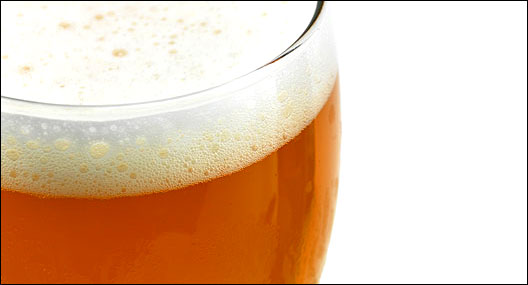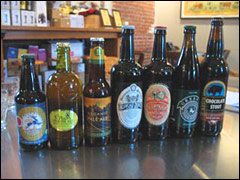
Why is beer so good?
The question has perplexed humanity since the dawn of agricultural civilization 10,000 years ago. Archeological records show that beer-making evolved with bread-making: both are ways of using fermentation to preserve grain, the first cultivated crop. To make beer, you let grain seeds germinate, mash them, hit them with some hot water, and let the resulting liquid ferment. Around 1100 A.D., likely in Belgium, an anonymous genius experimented with seasoning the resulting tipple by steeping it with a bitter flower called hops. Let’s just say it worked. (Burp.)
As for myself, I’ve quit puzzling over what makes beer so good. What I want to know is, which beer tastes best? And since I work for a green-minded publication, I’ll narrow my query yet more: Which organic beer is best?
It’s not necessarily an easy question to answer: The range of organic beers on the market remains pretty small, although it has been growing. And the organic beers that do exist tend toward the mellow side; so far, not many producers have gone organic with the new wave of craft-brewing that I’ve come to love — the highly hopped, high-alcohol (also called “high-gravity”) brews that New York Times critic Eric Asimov has labeled “extreme beers.”
Grist’s Pick
Samuel Smith and North Coast. But try any you can find! (And let us know how it tastes.)
Still, with an open mind and ready palate, I toured the supermarkets of Chapel Hill, N.C., and bought every organic beer I could lay my paws on. Happily, I found a broad range of styles, from light British lagers to a chocolate stout to Belgian-style heavyweights. Unhappily, there were a couple of major gaps in the available supply, as beer availability varies widely by region. I couldn’t find any Wolavers, the pioneering (and excellent) organic line from Otter Creek of Vermont. Nor did Stone Mill or Wild Hops, organic beers from mega-brewery Anheuser-Busch, turn up. I would have loved to have subjected those corporate products to the rigors of a blind tasting among true craft beers. Ah well, all the more reason to plan for a Round Two.
This time, I rounded up beer-loving friends and herded them into 3 Cups café, a kind of temple of flavor where I also held the Grist coffee tasting. The only time I could access the space was 11 a.m. on a Sunday — and the only people willing to sacrifice their Sunday morning to such an effort happened to be of the male persuasion. These hardy fellows included Mark Overbay of Counter Culture Coffee, community-garden activist Sammy Slade, chef Peter Brayshaw, and anthropologist Eric Karchmer (there for purely academic reasons). We tasted the seven beers blind, roughly from light to dark. I asked the panel to describe the color, aroma, flavor, and finish, and to score them from one to 10, with 10 being best. Here’s what we found.
St. Peter’s English Ale Organic
Origin: United Kingdom (Suffolk)
Alcohol: 4.5 percent
Price: $4.99/pint
Score: 5.4 out of 10
This “pale,” “mellow gold” brew from St. Peter’s — a brewery I usually find more interesting for its antique-looking oval bottles than its beer — had a solid but unspectacular showing. To me it had a yeasty, beer-hall aroma; others’ impressions included “apricot, nutmeg” and “light, faint.” On the tongue, we generally agreed it felt fizzy and light. I found the flavor brisk and refreshing, with a simple bitter finish; others got “lemony calendula” and honey hints.

A head to head competition of organic brews.
Photo: Courtesy of Tom Philpott
Lamar Street Organic Pale Ale
Origin: United States (Chicago)
Alcohol: 4.7 percent
Price: $6.99/six 12-oz. bottles
Score: 6.1
This is the Whole Foods house-brand organic, contract-brewed by Chicago’s highly regarded Goose Island Brewery. It looked pale gold with light copper tones; one of my comrades compared it to clarified butter. On the nose, two of us found super-faint malty-sweet notes; another picked up “poached pear and vanilla.” One taster compared its mouthfeel to a “down comforter on a cold night.” I found it slightly syrupy, a bit more ample than the previous beer. We generally agreed that it delivered a pretty good balance of sweetish malt and bitter (if simple) hops. One taster found “raisiny, tangelo” notes on the palate and “honeysuckle” on the finish.
Samuel Smith Organically Produced Old Brewery Ale
Origin: United Kingdom (Tadcaster)
Alcohol: 5 percent
Price: $2.99/pint
Score: 6.1
This one hails from Britain’s greatest old brewers. I found its color a lovely pale orange; another panelist compared it to Blueblocker sunglasses. I was its biggest fan, finding orange, sweet malt, and yeast notes on palate. I dug the mouthfeel, too: It felt more substantial than the previous ones, yet it danced on the tongue with champagne-like effervescence. On the palate, I found it citrusy, complex, and well-balanced by a longish hoppy finish. Another taster was equally enthusiastic until the finish, which for him “dropped into mediocrity.” One fan hailed its fruitiness, while its biggest detractor called it “thin, light, and sissy.” Ouch.
Samuel Smith Organically Produced Lager Beer
Origin: United Kingdom (Tadcaster)
Alcohol: 5 percent
Price: $2.99/pint
Score: 4.2
While the previous Sammy Smith wowed some of our panel, this ultra-light-colored beer impressed no one. I found it silky and effervescent on the tongue — and simple and uninteresting everywhere else. Variations on the theme of “watery” appeared in tasting notes; one compared it to a “college keg stand” and another said he might consider drinking it “after a long run.”
Bison Organic Chocolate Stout
Origin: United States (Berkeley, Calif.)
Alcohol: 6.1 percent
Price: $3.99/pint
Score: 6.2
This one, brewed with cocoa, showed as black as coal in the glass; after tasting all the previous lightweight beers, many of us were itching to dive into it. The aroma, too, promised something big and delicious. Promisingly, we found deep chocolate-coffee mocha notes on the nose. Alas, this beer didn’t deliver what we wanted from a pitch-black stout: velvety texture. “Surprisingly light” summed up the verdict. I found it sharp and bone-dry, with some interesting tobacco and leather notes. The assertive hops, though, seemed way out of balance for a stout. Another taster found an iron-like flavor he deplored. The consensus: not enough malt — which gives beer its sweetness and body — and too much hops. Another suggestion: roast the malts a little less. Like Starbucks coffee, this brew tasted a little burnt.
Green’s Endeavor All-Natural Dubbel Dark Ale
Origin: United Kingdom (contract brewed in Belgium)
Alcohol: 7 percent
Price: $6.49/pint
Score: 7
Confession: This beer isn’t certified organic. But get a load of the “all natural” text tag hanging on the bottle’s neck: “No wheat and or barley; crustaceans, eggs, fish, peanuts, soya beans, milk, lactose, nuts, celery, mustard, sesame seeds, sulphur dioxide, and sulfites.” Wow — I had to give it a try. Brewed from sorghum and rice (not the conventional barley), this beer can also be enjoyed by folks who can’t tolerate gluten. It smelled like a great Belgian beer — all wild yeasts and esters. Others picked up nuts and dates, and sea-salt/beefy hints. I found it round, effervescent, and champagne-like on the tongue, and a lovely candied-orange, citrusy flavor on the palate, backed up by a strong hops push on the finish. Others picked up cherry and raspberry flavors. Even its biggest detractor liked it quite well, but subtracted points because he found it “too carbonated.”
North Coast Cru D’Or Belgian-Style Ale
Origin: United States (Fort Bragg, Calif.)
Price: $6.99/four 12-oz. bottles
Alcohol: 8 percent
Score: 8.3
This organic offering from the stalwart California craft brewer ran away with top honors. Perhaps reflecting my mood after so many morning sips, I scribbled “beautiful copper hazy” to describe its appearance. “Pine sap,” “rusty,” and “murky brown-red” were other verdicts. On the nose, it just didn’t quit. I found yeast, toasted nuts, burnt sugar, and orange liquor; others found apple blossoms, cloves, and “dark mint.” I judged it big and effervescent, with powerful caramel, toffee, and orange notes leading to a gentle, mellow hop finish. Others declared it “smooth and lovely,” delivering “nice body” with nut, apple, and raisin flavors and “sassafras and grilled peaches” on the finish. Overall, a party in a bottle.
The bottom line: Organic beer remains in its infancy, constrained by a shortage of certified organic barley and hops. For that reason, many beer lovers find it a bit boring. This tasting forced me to reconsider lighter brew styles I’ve shied away from in recent years. The four lighter varieties were generally more interesting than I had expected, and I will certainly drink the Sammy Smith Old Brewery again. As for the dark beers, the Bison was a bust, but the two Belgian-style ones soared. (Come to think of it, I wouldn’t mind opening a bottle of the North Coast Cru D’Or right now … ) They give us hope that organic brewers are moving into more adventurous territory.
Special thanks to Badi Bradley of 3 Cups and Sujata Thapa for managing the tasting: the wise leading the blind.


